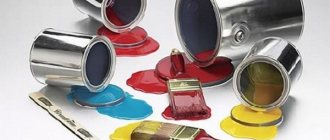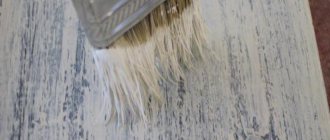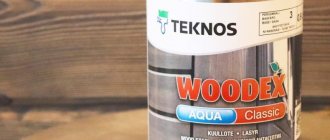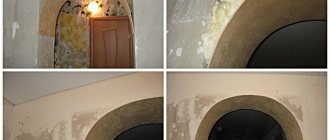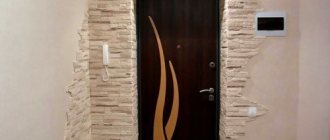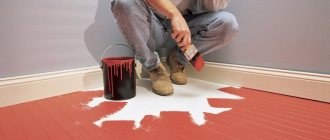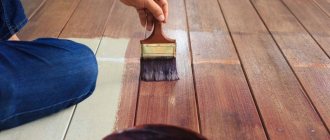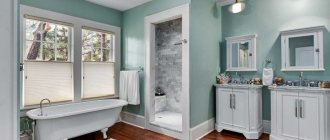Each material has its own properties. More often, a water emulsion is used to paint interior walls. It can be different due to the connecting elements included in its composition. It can be:
Freshly painted interior doors without the smell of paint are not a technological innovation. Many have appreciated this for a long time. It is more comfortable to work with odorless paint. The absence of a pungent odor indicates the safety of the material and increases its demand. Working with such compositions will not be laborious.
Why paint doors
An excellent choice for painting doors is a water-dispersion composition. It has a water base. This is a material safe for humans. Dispersion enamel is a combination of individual harmless elements soluble in water, which is a natural solvent. The advantages of the composition: complete absence of an unpleasant pungent odor, good drying speed, formation of a strong paint layer.
Acrylic paint, odorless, odorless, water-based enamel
Interior wood blocks are always primed before final painting. The finishing coating is selected taking into account the separated zones. Paint for interior doors is odorless, quick-drying, and can have different characteristics. If the door block separates the bathroom, the material must be water-resistant and have an antifungal effect. When the canvas is located on the sunny side, you need to take a composition with elements that prevent rapid fading.
Another thing is that each person has his own threshold of sensitivity to odor, with a corresponding adaptation to the chemical irritant, after which even the most pungent and volatile substances are practically not perceived.
One-component water-based polyurethane compounds dry on a prepared wooden floor for up to 5 hours. For comparison: alkyd material will dry in 8-10 hours, acrylic - 2-4 hours.
How to determine whether there will be a smell or not
Quick-drying acrylic compositions for painting batteries after drying provide good quality coating:
From domestic products you can use D-220 and Livna-134. The quick-drying, odorless paint for radiators under the VD AK1179 index from VGT is distinguished by high quality coating.
If the repair requires odorless paint for heating radiators, then acrylic enamel is best suited. Among the wide range of domestic and foreign painting materials, the most popular are the fast-drying acrylic enamels of the Finnish production Tikkurila Miranol and the German company JOBI called Termoaquaemal.
As you can see, today there are many materials for painting interior structures and they all have properties and characteristics that are different from each other. Thanks to odorless paints, you can paint and decorate doors at any time of the year, without fear that you will not be able to stay indoors for some time. Such materials make repairs much more comfortable and convenient.
Decorative painting of an interior door consists of the following stages:
Painting interior structures made of MFD involves the following steps:
Using charcoal and coffee beans
These substances also have good sorbing characteristics.
You need to do this:
- Grind the material. When working with charcoal, you can operate manually (just wear work gloves). A coffee grinder is usually used to grind coffee beans. The grind level should be coarse.
- Pour the prepared sorbent into bowls in a thin layer. For larger spaces, you can use dishes or trays. Stands with material are evenly placed on the floor or stools.
- The duration of the procedure is until the air is completely purified. This usually takes at least 12 hours. The door to the room must be tightly closed.
- After finishing cleaning, the contents of the trays are poured into bags and taken to the trash.
Let's sum it up
Do not forget that for high-quality painting, the process must take place in several stages, the drying interval between which must ensure complete drying of the applied layer. Only when the last layer is completely dry will it be possible to install the fittings.
- Methods for restoring doors from different materials
- Instructions on how to remove the trunk door trim
- Types and installation of doors for greenhouses
Today, the modern market offers a huge selection of impregnations, tinting, paints, and varnishes. From all this variety, you need to choose the right odorless paint for interior doors. To do this, you should choose the best material that will match the quality, properties, color, method of exposure and price.
You can quickly and inexpensively update MDF doors using paint. However, during dyeing, the solvents that are part of the raw materials emit strong unpleasant odors. But these days, odorless paint for interior doors is already being created and produced: what to choose? Let's talk about this in more detail.
Oily
Another important quality is that latex paint is odorless and quick-drying at the same time, and has excellent wear resistance. That is why it is often used for painting ceilings and any walls (plaster, brick).
At first glance, odorless interior paint is available in many stores, which simplifies the search. When choosing a paint composition, you need to take into account the type of surface. There are several types of harmless paint and varnish products:
It is noteworthy that modern technologies make it possible to obtain completely safe paint that is easy to use (when carrying out renovation work indoors, it is important that nothing stinks).
Odorless latex enamel paint is one of the types of water-dispersed materials, where latex acts as a dispersion. Such paints and varnishes are non-toxic and do not have an unpleasant odor, and therefore are actively used in interior decoration.
Choosing odorless paint for apartment renovation is easy at first glance. But this is not entirely true; the choice of material is influenced by the type of surface that will be processed. Among the harmless paint and varnish products, several types can be distinguished:
Painting the ceiling and walls is done with a special roller; odorless, quick-drying wall paint is evenly distributed on the surface. Water-based paints and varnishes, such as latex, are often used. If the process requires application in several layers, then the procedure can be repeated after some time, since the odorless and quick-drying water-based ceiling paint dries quickly. This odorless wall paint is easily washed off from hands and tools with ordinary water.
Using an open flame
Volatile toxic substances are neutralized by direct contact with open fire. If possible, turn on a gas burner in the room for a short time (like those used when installing PVC stretch ceilings). It is clear that such a radical method will not work everywhere.
You can also use regular candles, evenly placing them on safe stands. Such cleaning may only be carried out under constant supervision. A safer option is to “work out” the room with a simple “wind blower” heater. The air in such devices is forced through a hot metal sieve, where the toxins will “burn off.”
Water-dispersed
The disadvantages of such products include the price, it is a little high, but thanks to its high performance qualities, it works out its value.
These odorless floor paints are used for wood when performing interior and exterior work. With their help it is easy to paint metal surfaces, wood, and concrete. They can even be used when painting plaster. But still, odorless oil paints on wood also have a significant disadvantage - they take a long time to dry due to the solvent for odorless oil paints. They are usually used for interior work in non-residential premises.
Before carrying out interior work, it is necessary to determine the surfaces that will be treated. The fact is that each surface uses its own type of paint and varnish materials. The most common work in a residential area is painting:
Odorless latex waterproof bathroom paint has good wear resistance. Therefore, it is often used when painting ceilings, any walls - plastered, brick and even covered with wallpaper. In addition, it does not dry out or swell; it is advisable to use it when finishing rooms with high humidity, for example, kitchens and bathrooms.
Today, the modern market offers a huge selection of impregnations, tinting, paints, and varnishes. From all this variety, you need to choose the right odorless paint for interior doors. To do this, you should choose the best material that will match the quality, properties, color, method of exposure and price.
What color should I paint it?
Which paint is best to paint interior doors involves choosing a color. The appropriate shade for painting interior doors is selected to match the tone of the exterior interior. The door block should be in harmony with the surrounding environment.
The presence of warm colors and furniture made of natural wood in the room requires the use of paint with a tint that matches the wall or furniture wood shade.
You can choose a paint color that will match the color of the carpet covering the floor or linoleum. In a room with a predominance of cold tones, it is better to make a smoothly painted white block. This shade suits any interior if the window frames and ceiling are covered in a similar white tone. The corrugated snow-white canvas can be decorated with colored strokes. The color of the drawn lines can match the color of the baseboard, wall pattern, or interior decoration.
Main stages
Painting interior structures made of MFD involves the following steps:
Decorative painting of an interior door consists of the following stages:
You can quickly and inexpensively update MDF doors using paint. However, during dyeing, the solvents that are part of the raw materials emit strong unpleasant odors. But these days, odorless paint for interior doors is already being created and produced: what to choose? Let's talk about this in more detail.
The painting process begins with the door frame, gradually moving towards the canvas. First, the door is painted closed, then it is opened slightly and gradually painted on opposite sides. The composition is applied from top to bottom, and it should be shaded correctly. At the end of the work, the structure is completely opened and the room is ventilated.
In most apartments and houses, doors are made of wood or its equivalent. This solution is more economical and does not require special care. Based on this, it is important to choose a paint for wood or a universal composition. Specialized coatings are more expensive, but they will also last longer than budget models, this is important to consider.
Painting a door brown, black, white or clear is not that difficult. To complete this activity, you should buy a construction brush, a jar of varnish or enamel and a solvent. After completing the points, begin painting activities. But there's no need to rush. It is important to take into account every nuance so that the final result does not become a disappointment.
Nuances you need to know when painting windows and doors
It would seem that nothing could be simpler than painting a window or door. Many people think that it is enough to get a brush, buy a can of paint and, just in case, grab a solvent so that you have something to wash off this very paint, and you can get to work. But even here there are some peculiarities that you need to know about so that the painting is of high quality and does not spoil the overall impression of the repair.
Windows and doors are first prepared for painting. First of all, the fittings and mechanisms are removed, the glass around the perimeter is covered with masking tape. The previous layer of old paint or varnish is removed from wooden surfaces using a special remover and a spatula. Visible defects are repaired with wood putty, nicks are sanded with fine-grained sandpaper, and the surface itself is impregnated with an appropriate primer to prevent paint from being absorbed into the wood.
The process of sanding and then varnishing the door leaf makes it resistant to damage and elegant.
Tips for vertical painting
Selecting paint is a difficult task. The external factors that the door will encounter should be taken into account. Some people have never changed the design, which is why it is covered with a thick layer of paint, and by applying another composition, the appearance will become untidy. Therefore, before painting, it is necessary to remove the previous layer.
Difficulties in choosing paint begin when a person buys paintwork materials that are not suitable for their intended purpose. There may be an inscription “for wooden surfaces”. However, it can only be used for facades. There are 3 types of materials for wood:
A flat brush made of natural bristles is suitable for solvent-based coatings. To check the quality of the tool, you should pull it by the bristles; if it remains in your hands, it is not recommended to buy such a product. The dimensions of the product must correspond to the area to be painted. Elements measuring 50 mm are considered a suitable option; narrow brushes are purchased for hard-to-reach places.
There is also a downside - an unpleasant odor that will remain in the apartment for 48 hours. If you do not ventilate the premises, it will take even longer. Therefore, it is recommended to carry out painting outside or in the garage. It won’t take much effort; you just need to remove the door from its hinges.
In order for the composition to dry really quickly, and for the coating it creates to serve you for a long time, you must follow the application technology. This is a simple job that can be done with your own hands. The main thing is to know all the tricks and nuances.
As you can see, it is impossible to determine the paint that will suit you best. However, enamel is considered the most versatile and stylish composition. This option is quite expensive, so not everyone can afford it.
Useful parameters that are taken into account when choosing
Choosing paint is a simple process. Most of the problems arise when people buy paint that doesn't match the surface. Paint and varnish materials are divided into types:
- Transparent. They have a special pigment that can amazingly accurately copy the structure of wood.
- Opaque mixtures. They are based on organic solvents. These include oil, alkyd and a number of other options.
- Odorless solutions. The smell quickly disappears, and the material itself dries in a matter of minutes.
Attention! Door paint, especially acrylic, is a good design choice. This is explained by the impressive color range. Therefore, you should not immediately abandon acrylic or other paint options. Initially, you should familiarize yourself with the advantages of materials, and only then choose the right one.
How to choose paint that doesn't smell
There are a lot of options for quick-drying compounds. Therefore, you need to learn how to choose the right one from all the abundance presented.
Quick-drying wood paint should be safe for health. In addition, such a coating must have a sufficiently long service life.
It is also important to know that in order for the paint to lay as evenly as possible, you must work with it at a temperature of at least 10 degrees. You can use the door no earlier than 24 hours after painting.
All options described are considered safe. They are great for decorating interior doors.
To apply paint, you can use either a spray gun or a regular roller. Complete drying of the first layer of coating takes about 3 days. After this time, you can use the painted surface, or apply the next layer, but in this case it will take a little longer to dry. During painting work, the temperature should not be lower than 10°, and the air humidity should not be higher than 75%. You should also protect the drying surface from direct sunlight.
This condition corresponds to 2 types of paints: water-dispersion (water-based) and acrylic. Recently, they are increasingly used when painting wooden elements. Water-based paint is used for walls and ceilings, and acrylic paint is used for floors, windows and doors.
Before answering the question, you need to understand why most of the paints used have a pungent odor. The thing is that they contain organic solvents. These components are part of almost all enamels used for repairs since ancient times. This means that in order to solve the problem of pungent odors, you need to choose products that do not contain organic solvents.
Wet cleaning of painted surfaces
Wet cleaning of painted substrates helps to quickly get rid of odor. However, if you use plain water, the effect will be negligible.
The following additives are used to prepare aqueous solutions:
- Dry mustard. Add 1-2 tablespoons of the substance into a 10 liter bucket of warm water. Having crushed the liquid, wipe the painted bases with it (it is more convenient to do this with a sponge). As a rule, this option is used for processing wooden surfaces.
- Vinegar or ammonia. The concentration here is slightly less - 1 tbsp. l./5 l of cold water. The prepared solution can be used for wiping wood, metal and plastic substrates.
Acrylic paint without odor
The use of acrylic-based paints and varnishes will not cause any particular difficulties. First, the surfaces are cleaned of various contaminants and dried very thoroughly. If there are places where resin comes out, they are cleaned out until they reach clean wood. Then the resulting recess is puttied and smoothed with sandpaper.
The most important advantages of these paints and varnishes are the absolute absence of harmful odors, the presence of only natural ingredients, which allows painting work even in children's rooms. The following qualities are also important:
If desired, a properly prepared surface can be coated with a deeply penetrating acrylic primer. The most optimal result is achieved if both the paint and primer are from the same manufacturer.
These compounds are fireproof. Of course, they won’t protect you 100% from fire, but they will reduce damage from unintentional fire.
Polyvinyl acetate paints dry quickly. But at the same time, when purchasing such materials, you should take into account: compositions that contain certain additives are suitable for facade work.
It is recommended to apply paints to a previously prepared surface. To do this, you need to remove old paintwork and dirt from the wood, and also degrease it with solvents or alcohol. In addition, large cracks should be filled with putty. Paint can hide minor defects.
Preparatory work
In order for the door to dry faster, before painting it must be removed from its hinges and taken outside.
A new wooden door is treated with antiseptic compounds and primed. On a previously painted sash, remove the paint if it has peeled off and does not adhere well. The smooth and solid coating is not touched, only sanded with sandpaper and painted in another chosen color. Natural wood is sanded to an ideal surface.
To make it convenient to work, perform the following steps:
- the canvas is removed from the hinges, sometimes you just need to lift the sash and remove it from the hinge pin, in other cases the screws on the hinge are unscrewed;
- remove the lock, handle, decorative lining on the key cavity.
It is best to remove the old layer with a hair dryer. You need help with a spatula and sandpaper. After heating, use a spatula to pry off the paint film and remove it. The remaining particles are sanded off. You need to work carefully so as not to damage the door area.
You can use paint remover. The solution penetrates deep into the film and makes it soft, after which it can be easily removed with a spatula. The chemical method works faster, but the product is toxic; you need to use a respirator. With the use of the product, the risk of damaging the area is reduced; the solution is inexpensive.
Putty completes the preparatory stage. The canvas is leveled over the entire area or only cracks are sealed. After the putty has dried, the layer is sanded to a perfect surface.
